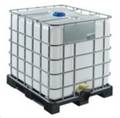Please sign in so that we can notify you about a reply
SAFETY INFORMATION
| Danger |
 |
| H314 Causes severe skin burns and eye damage. |
| P280 Wear protective gloves/ protective clothing/ eye protection/ face protection. |
| P301 + P312 IF SWALLOWED: Call a POISON CENTER or doctor/ physician if you feel unwell. |
| P303+P361+P353+P310 IF ON SKIN or hair: Remove/Take off immediately all contaminated clothing. Rinse skin with water. Immediately call a poison centre or doctor/physician. |
| P305 + P351 + P338 IF IN EYES: Rinse cautiously with water for several minutes. Remove contact lenses, if present and easy to do. Continue rinsing. |
| P308 + P310 IF exposed or concerned: Immediately call a POISON CENTER or doctor/ physician. |
Acetic Acid 80% in a non-returnable 1000L IBC
Acetic acid (also known as ethanoic acid) is an organic compound with the chemical formula CH3COOH (also written as CH3CO2H or C2H4O2). It is a colourless liquid which when undiluted is also called ‘glacial acetic acid’. Acetic acid is the main component of vinegar (apart from water; vinegar is roughly 8% acetic acid by volume), and has a distinctive sour taste and pungent smell. Besides its production as household vinegar, it is mainly produced as a precursor to polyvinylacetate and cellulose acetate. Although it is classified as a weak acid, concentrated acetic acid is corrosive and attacks the skin.
Acetic acid is one of the simplest carboxylic acids. It is an important chemical reagent and industrial chemical, mainly used in the production of cellulose acetate for photographic film and polyvinyl acetate for wood glue, as well as synthetic fibres and fabrics.
In the home, diluted acetic acid is often used in descaling agents.
In the food industry, acetic acid is used under the food additive (EU number E260) as an acidity regulator and as a condiment. It is widely approved for usage as a food additive.
NOTE: THIS PRODUCT CANNOT BE DELIVERED TO A DOMESTIC ADDRESS
PRICE INCLUDES DELIVERY TO ENGLAND AND WALES IN SEVEN DAYS



